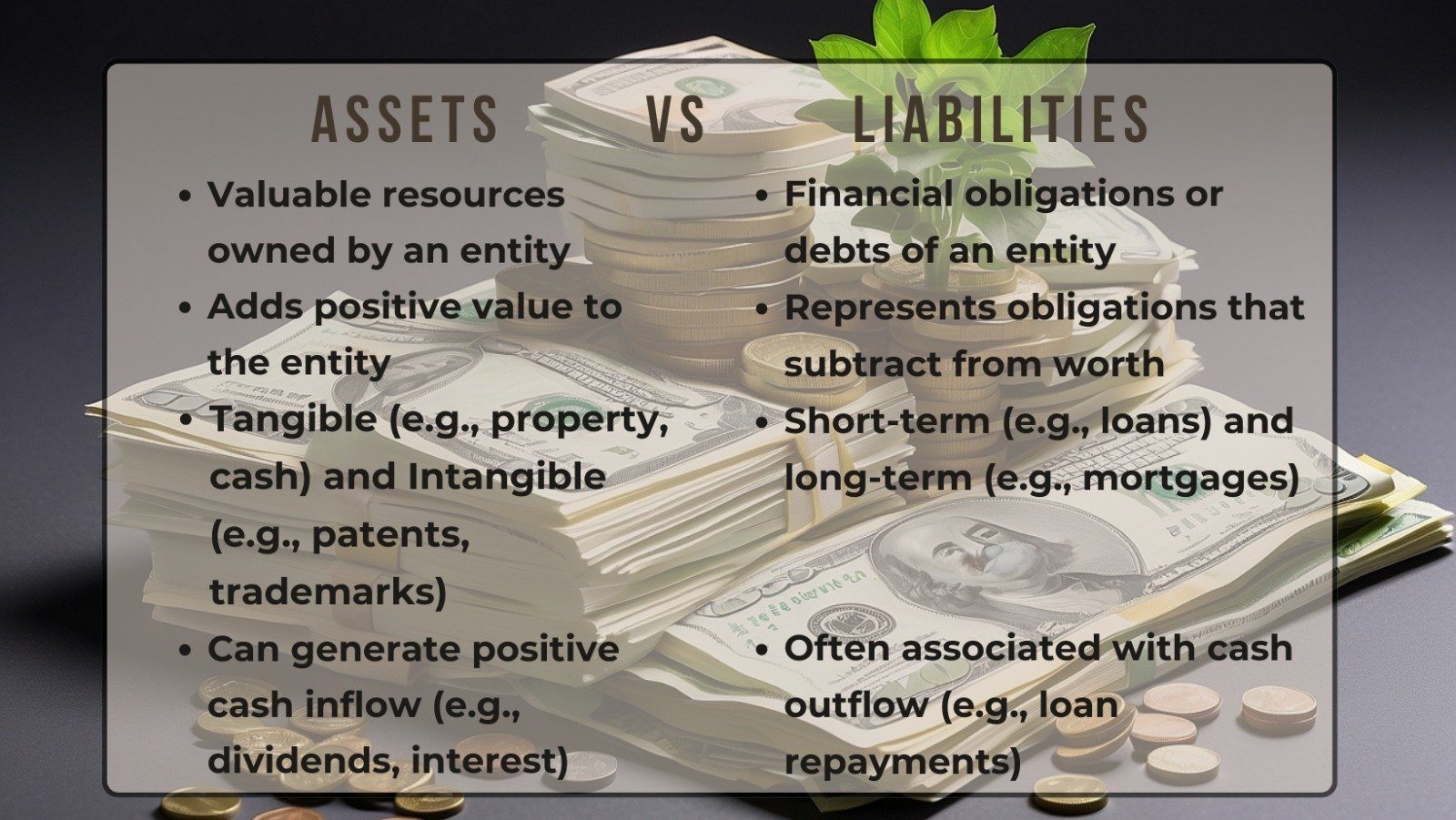Net worth is increased by assets, while financial obligations are represented by liabilities. Building a long-term financial foundation and making smart decisions require prioritizing assets for passive income and reaching financial objectives.
In Short
If you want to be successful in managing your personal or company finances, you need to be able to tell the difference between these two. You could be in financial trouble if you mistake an obligation for an asset. My question is, what is the best way to avoid that?
In all facets of personal finance, including budgeting and investing, understanding this distinction is vital. If you want to improve your net worth or stay out of debt traps, understanding this difference might help you financially in the long run. Interested in learning more? Shall we begin?
Difference between assets and liabilities
Assets are valuable items you own, such as your home, car, funds, or investments. It increases your financial situation by raising your net worth.
Liabilities, such as mortgages, loans, or credit card bills, represent financial obligations or debts owed to others. While assets increase your financial power, liabilities decrease it, and understanding this distinction is vital for effective personal finance management.
What Are Assets?
Assets are valuable possessions or resources that an individual, company, or organization owns and controls, contributing positively to their overall financial worth.
Examples of assets include properties, investments, cash, and other items with monetary value.
What Are Liabilities?
Liabilities are financial obligations or debts that an individual, company, or organization owes to others. These are the sums of money or resources that must be paid back or fulfilled in the future.
Examples of liabilities include loans, mortgages, credit card balances, and other financial commitments.
Assets Vs. Liabilities

| Category | Assets | Liabilities |
|---|---|---|
| Meaning | Valuable resources owned by an entity | An entity may have financial obligations or debts |
| Description | Adds positive value to the entity | Represents obligations that subtract from worth |
| Types | Tangible (e.g., property, cash) and Intangible (e.g., patents, trademarks) | Short-term (e.g., loans) and Long-term (e.g., mortgages) |
| Cash Flow Impact | Generating Positive Cash Inflow (e.g., dividends, interest) | Often associated with cash outflow (e.g., loan repayments) |
| Examples | Property, equipment, investments, cash | Loans, accounts payable, mortgages |
Examples of Assets and Liabilities
Asset
Suppose you have purchased a property as a long-term investment. The property’s worth may rise over time, making it a valuable asset for you. You can even make money by renting it out. This property, which is considered a significant asset, has the potential to provide passive income.
However, bear in mind that purchasing the property for personal use, which entails maintenance and other expenses, could potentially cause issues.
Liability
On the other hand, if you buy a car for personal use, it may be deemed a liability. While it provides convenience and transportation, it does not generate money and incurs constant expenses such as fuel, maintenance, and insurance.
In this situation, the car is more of a liability because it does not contribute to passive revenue and necessitates ongoing expenses.
Assets and Liabilities in Everyday Life
Have you ever wondered why some people seem to accumulate wealth effortlessly, while others struggle with debt? Knowing your assets from their liabilities is usually the key. This distinction is crucial for managing your daily finances effectively. Every monetary move you make, from purchasing a vehicle to repaying a loan, may either enhance your assets or your liabilities.
Consider this: An individual purchases a residence. What kind of asset or liability is it? Is your credit card debt a problem for you? Understanding the concept of assets versus liabilities is crucial for making informed decisions in all aspects of your life, including financial matters.
Let’s take a quick look at the relationship between assets and liabilities in everyday life.
| Category | Assets | Liabilities |
|---|---|---|
| House | Own home that increases in value | Mortgage or loan payments |
| Car | Car generating business income | Car loan or depreciating personal vehicle |
| Savings | Investment accounts, savings | Credit card debt, student loans |
| Business | Business generating profits | Business debts or unpaid suppliers |
Assets, Liabilities and Passive Income
To increase passive income, it is essential to prioritize assets over liabilities. Assets are precious resources that can provide revenue over time. Investing in stocks, real estate, or creating content that produces royalties, for example, can all be considered assets. These assets can potentially contribute to passive income streams, enabling you to generate income without constant engagement.
But liabilities, including out-of-pocket costs or non-profitable resources, usually don’t add to passive income growth.
If you want to build a passive income stream that will last for a long time, you need to put your money into things that can earn you cash. Individuals can work toward financial goals and generate prospects for income growth by focusing on assets rather than relying primarily on active efforts.
Final Thoughts
Understanding the difference between assets and liabilities is crucial for making informed financial decisions. Assets, such as tangible assets like property and intangible investments, enhance an entity’s worth and generate income. Liabilities, on the other hand, are financial obligations or debts that subtract from an entity’s worth, such as loan repayments or credit card balances. This helps individuals and businesses strategize effectively, prioritizing asset growth for long-term financial well-being and responsibly managing liabilities. Leveraging assets to build wealth leads to a robust and sustainable financial foundation.
FAQ
What is the difference between current assets and liabilities?
Current assets and liabilities are distinct financial concepts. Current assets are resources a company expects to convert into cash or use up within a year or operating cycle, such as cash, accounts receivable, and inventory. On the other hand, current liabilities are obligations that a company expects to settle within a year, such as accounts payable, short-term loans, and accrued expenses. These assets are expected to provide future economic benefits, while liabilities are obligations that need to be settled in the near term.













Leave a Reply